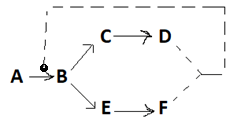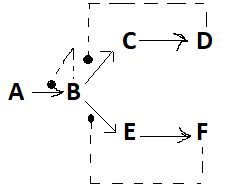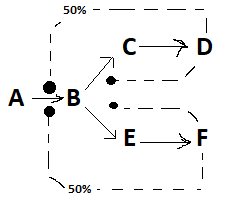This set of Fermentation Technology Multiple Choice Questions & Answers (MCQs) focuses on “Industrial Microorganisms – Feedback Control”.
1. The levels of primary metabolites are regulated by _______
a) Feedback mechanism
b) rDNA Technology
c) Incubating the microorganism in dark
d) Adding the inhibitors
View Answer
Explanation: The levels of primary metabolites are regulated by the Feedback mechanism. Feedback inhibition and feedback repression are the main systems of the Feedback mechanism.
2. Feedback repression occurs at ______
a) protein level
b) gene level
c) transcriptomic level
d) expression level
View Answer
Explanation: Feedback repression occurs at the gene level to prevent transcription and thus preventing enzyme synthesis. It switches off the genes products which are needed to maintain the function of the cell.
3. Feedback repression is a situation where the end product of a pathway inhibits the activity of enzyme catalyzing the first reaction.
a) True
b) False
View Answer
Explanation: Feedback inhibition is a situation where the end product of a pathway inhibits the activity of enzyme catalyzing the first reaction. It decreases the activity of the enzyme which increases the rate of the first reaction.
4. Which of the following is not a type of Feedback control?
a) Concerted
b) Cooperative
c) Isotopes
d) Cumulative
View Answer
Explanation: The types of feedback control are concerted, cumulative, cooperative, isoenzyme, sequential feedback controls. Whereas isotypes are the elements with the same proton number but different neutron number.
5. Which of the following control system involves the control of the pathway by more than one end product?
a) Concerted
b) Cooperative
c) Cumulative
d) Sequential
View Answer
Explanation: Concerted or multivalent system involves the control of the pathway by more than one end products. The first enzyme gets repressed when all the end products are in a greater amount of excess.
6. Which of the following control system involves the control of the pathway by each end product independently?
a) Concerted
b) Cooperative
c) Cumulative
d) Sequential
View Answer
Explanation: Cooperative control system involves the control of the pathway where the control is affected by each end product independently. The degree of inhibition caused by the sum of all products is much higher than the individual effects.
7. Which of the following control system involves the control of pathway by certain percentage independently of the other end products?
a) Concerted
b) Cooperative
c) Cumulative
d) Sequential
View Answer
Explanation: Cumulative control system involves the control of the pathway where the first enzyme gets independently inhibited by a certain percentage of end products. Here, each end products reduce the activity of the first enzyme independently of all other end products.
8. Which of the following control system involves the control of pathway after the branch point to the product?
a) Concerted
b) Cooperative
c) Cumulative
d) Sequential
View Answer
Explanation: Sequential control system is a system where each end product of the pathway controls the enzyme immediately after the branch point to the product. This mechanism usually results in an accumulation of the last metabolite od biological pathway.
9. Feedback inhibition is the situation where the end product of the pathway prevents the synthesis of an enzyme catalyzing reaction of a pathway.
a) True
b) False
View Answer
Explanation: Feedback repression is the situation where the end product of the pathway prevents the synthesis of an enzyme catalyzing reaction of a pathway. It suppresses the activity of gene which produces products useful for catalyzing a particular reaction.
10. Which of the following catalyze the same reaction but are different in their control characteristics?
a) Isoenzyme
b) Alloenzyme
c) Poison
d) Isotopes
View Answer
Explanation: Isoenzymes are the enzymes that catalyze the same reactions but are different from their control characteristics. Poisons are the substances which decrease the enzymatic activity. Isotopes have the same proton number and do not catalyze a reaction. Alloenzymes differ structurally and not functionally.
11. Name the feedback control.

a) Concerted
b) Cooperative
c) Cumulative
d) Sequential
View Answer
Explanation: The schematic diagram represents the concerted feedback control where the first enzyme is inhibited by end products which are in excess. Here, only the excess end products are able to suppress the activity of the first enzyme.
12. Name the Feedback control.

a) Concerted
b) Cooperative
c) Cumulative
d) Sequential
View Answer
Explanation: The schematic diagram represents the Sequential feedback control where each end product of the pathway controls the enzyme immediately after branch point to the product.
13. Which of the following is not true for the feedback system?
a) It controls the production of primary metabolites
b) It inhibits the synthesis of the main enzyme of the pathway
c) It blocks the allosteric site of the main enzyme of the pathway
d) It prevents product formation
View Answer
Explanation: The Feedback System controls the production of primary metabolites by inhibiting the synthesis of the main enzyme or by blocking the allosteric site of the main enzyme of the biochemical pathway.
14. Name the Feedback control.

a) Concerted
b) Cooperative
c) Cumulative
d) Sequential
View Answer
Explanation: The schematic diagram represents the cumulative feedback control where the first enzyme gets independently inhibited by 50% by end products. The last metabolite gets accumulated in this type of mechanism.
15. Name the Feedback control.

a) Concerted
b) Cooperative
c) Cumulative
d) Isoenzyme
View Answer
Explanation: The schematic diagram represents the Isoenzyme feedback control where the end products D and F control the catalytic conversion of A ⟶ B. Here, the different isoenzymes are controlled by different end products.
Sanfoundry Global Education & Learning Series – Fermentation Technology.
To practice all areas of Fermentation Technology, here is complete set of 1000+ Multiple Choice Questions and Answers.
If you find a mistake in question / option / answer, kindly take a screenshot and email to [email protected]
- Practice Biotechnology MCQs
- Check Biotechnology Books
- Apply for Chemical Engineering Internship
- Check Fermentation Technology Books
- Check Chemical Engineering Books
